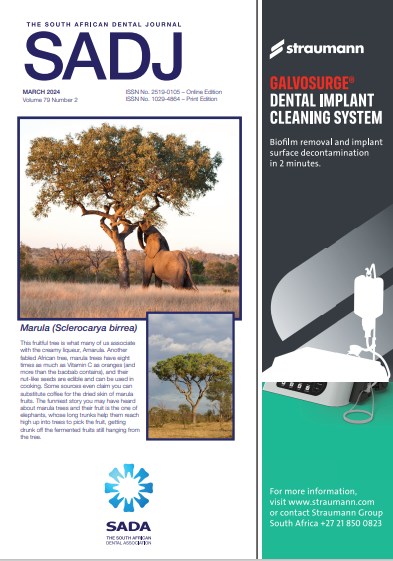MAXILLOFACIAL RADIOLOGY Double type III dens invaginatus
Keywords:
nasopharynx.Abstract
A 75-year-old female presented for a follow-up appointment for the construction of an implant-retained prosthetic nose.
During the appointment, a prosthetic pin unintentionally dislodged into her nasopharynx. The following serial radiographs (Fig
1-3) were taken to determine the location of the pin, with a main concern of dislodgement into the patient’s lungs.
In Fig 3, the pin (black arrow) can be seen in the colon. This is an indication that the pin was not aspirated but ingested,
implying that no further medical intervention was necessary.
Downloads
References
Venkataraghavan, K., Anantharaj, A., Praveen, P., Rani, S.P. and Krishnan, B.M. Accidental Ingestion of a Foreign Object: Systematic Review, Recommendations and Report of a Case. The Saudi Dental Journal 2011; 23(4):177–81.
Saraf, H.P., Nikhade, P.P. and Chandak, M.G. Accidental Ingestion of Endodontic File: A Case Report. Case Reports in Dentistry, 2012. https://doi. org/10.1155/2012/278134
Naderian, A., Baghaie, H. and Satchithanandha, V. Accidental Ingestion of An Endodontic File: A Case Report. Journal of Medical Case Reports 2022; 16(1): 1–5. https://doi.org/10.1186/s13256-022-03363-1
Guelfguat, M., Kaplinskiy, V., Reddy, S. H., and DiPoce, J. Clinical Guidelines for Imaging and Reporting Ingested Foreign Bodies. American Journal of Roentgenology 2014; 203(1): 37–53. https://doi.org/10.2214/AJR.13.12185
Zitzmann, N.U., Elsasser, S., Fried, R. and Marinello, C.P. Foreign Body Ingestion and Aspiration. Oral Surgery, Oral Medicine, Oral Pathology, Oral Radiology, and Endodontology 1999; 88(6):657–60.
Downloads
Published
Issue
Section
License

This work is licensed under a Creative Commons Attribution-NonCommercial 4.0 International License.





.png)